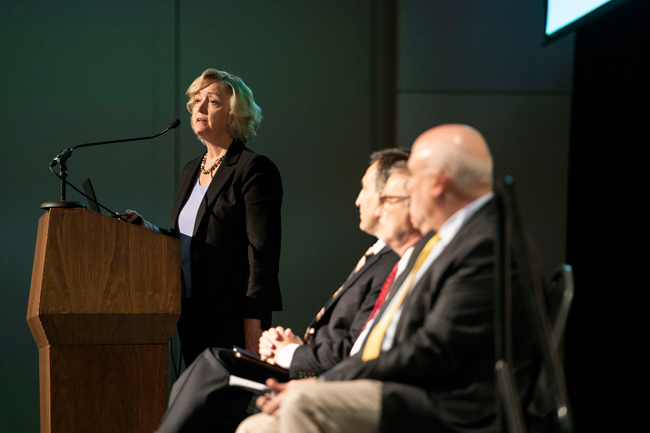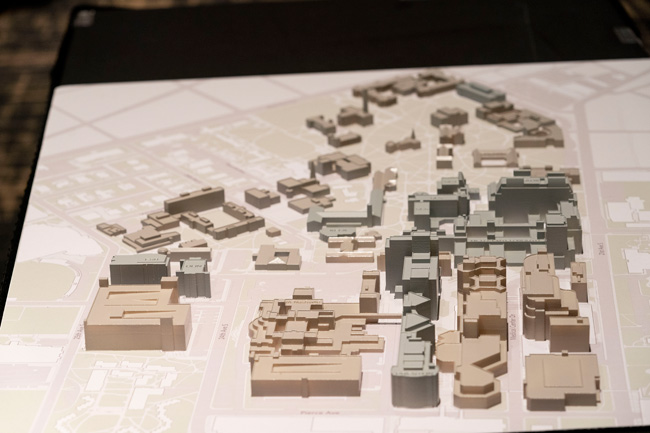A recent town hall meeting brought together senior university leaders and several hundred Vanderbilt community members to discuss the findings of two capital improvement studies—one looking at the current and future facility needs in the science and engineering disciplines, and the other seeking to update and revitalize College of Arts and Science buildings in the university’s historic core.
The March 28 event at the Student Life Center was an opportunity to update the campus on conceptual planning currently underway as well as dialogue with community members and answer questions.
“What we’re talking about today is not an execution plan but is intended to continue the dialogue about what our priorities are and what our next steps should be in terms of our short-term, middle-term and long-term planning,” Provost and Vice Chancellor for Academic Affairs Susan R. Wente said. “The two studies we’ve engaged in … take into account not only FutureVU, but also the Academic Strategic Plan, our One VU focus and also the needs and aspirations of continuing to support our trans-institutional programs and efforts.”

In early 2018, Wente launched a discovery process to better understand the university’s building capacities for the sciences, engineering, and arts and humanities so the university could develop trans-institutional plans for the future.
The university hired two consultants—HDR to study science and engineering needs, and the DLR Group to examine the Arts and Science historic core, which includes the humanities and several social science departments. The consultants engaged faculty, deans, department chairs, center and institute directors, advisory committees, working groups and others and collected feedback to inform the creation of one-, three-, five-, 10- and 20-year concept plans for the future development of campus.
FutureVU, which launched in 2015, was initially envisioned as a holistic view of the Vanderbilt campus in support of the Academic Strategic Plan, Vice Chancellor for Administration Eric Kopstain said.
“As we think about our buildings, our outdoor spaces, the connectivity of the campus—how do we ensure that we’re weaving things together in a way that meets all of the objectives of this institution in terms of teaching and learning and research and innovation?” he said. “We have the responsibility as stewards of this institution to take a long view on our facilities and on our people.”
The FutureVU framework is driven by guiding principles, which include extending the unique identity and character of the oldest part of campus—the historic core—to all parts of campus as well as potential new construction. Another guiding principle is to create a community of interconnected neighborhoods across Vanderbilt.

“One of the big findings and observations is that at a pedestrian level … our neighborhoods are not all well-connected. Connectivity is a key theme,” Kopstain said. For example, “the current West End Neighborhood construction includes a beautification effort to make that neighborhood feel more connected at a pedestrian level to the historic core, and, as a result, also make it feel more inclusive and welcoming for our community.”
The deans of the School of Engineering, School of Medicine Basic Sciences and College of Arts and Science are working in a highly integrated, trans-institutional way to find opportunities for collaboration among their schools in terms of capital investment.
The School of Engineering’s mission is “to develop trans-institutional research opportunities that would position the university—but specifically the Basic Sciences, Arts and Science, and the School of Engineering together—to become a leader in selected fields of research with societal impact. That’s really what we strive to do,” said Philippe Fauchet, Bruce and Bridgitt Evans Dean of Engineering and professor of electrical engineering. “And at the same time to improve our own undergraduate teaching labs, including developing maker spaces and other spaces suitable for immersion. Those two things are not exclusive—they work together.”
One way these collaborative spaces could take shape is in the form of a science, technology, engineering and math “spine” on campus that would run from MRB III and the Stevenson Center complex through Featheringill Hall and the FEL Building to the Engineering and Science Building, Fauchet said.
“And that, I think, is really exciting in many ways to have all the scientists, the engineers, all close to one another so that interactions are facilitated. I think that would make a strong statement about science and engineering at Vanderbilt,” he said.
Initial priorities include building out the three “shell” floors of the current Engineering and Science Building in cooperation with the other deans, Fauchet said, and finding permanent homes for the Vanderbilt Data Science Institute, which launched last August, and other trans-institutional centers.

Vanderbilt is one of the best places in the world to do basic biomedical research, said Larry Marnett, dean of basic sciences in the School of Medicine and the Mary Geddes Stahlman Professor of Cancer Research. Three of Basic Sciences’ four departments currently rank in the top three for NIH funding in the United States, and the fourth is in the top 10.
“We’ve got talented and entrepreneurial faculty who are capable of making world-class discoveries and training the next generation of leaders,” said Marnett, who cited Basic Sciences’ myriad collaborations with clinical colleagues in the School of Medicine, as well as with faculty in Engineering and Arts and Science, as key to his division’s strength.
Basic Sciences currently leases two-thirds of its space from Vanderbilt University Medical Center and off-campus facilities, and some areas—such as its Biomedical Research Education and Training office—are significantly space-constrained, Marnett said. The construction of a new trans-institutional life sciences building—a proposal still in the fact-gathering stage—would enable Basic Sciences to move some of its faculty out of leased space and apply that rent to a dedicated building.
“We’ll only commit to a new building if the overall balance between cost and opportunity is beneficial for us, and there isn’t enough information at this point to make that decision,” Marnett said. “We’re fortunate that we don’t have to leave our leased space to do good science.
“Nevertheless, we are excited by the possibility of participating in a new trans-institutional life sciences building that would be part of a ‘spine of science’ across Vanderbilt that interfaces on one side with the historic core of the university and on the other side with VUMC,” he said.
In the short- to mid-term, updating and renovating the labyrinthine Stevenson Center complex to make it easier to navigate, more habitable, and give it a unified identity as a science and engineering hub on campus is a priority.

In addition to fostering trans-institutional collaboration with Engineering and Basic Sciences, Arts and Science is focused on nurturing collaboration within the college and its existing buildings, including creating a welcoming and centrally located center for humanities on campus.
“One of the things that we need to do is to think about our space holistically and make sure we’re not in any way, shape or form building silos either physically or intellectually,” said John Geer, dean of the College Arts and Science and Gertrude Conaway Vanderbilt Professor of Political Science.
“The actual amount of space we need, new space, isn’t at all clear,” he said. “What we really need to do for the most part is to renovate existing space in a way that allows an alignment between space and our mission.”
Major renovation and addition projects are planned for Calhoun, Garland and Furman halls, among other buildings in the historic core, and a major component of these projects will be addressing the older buildings’ infrastructure and accessibility needs.
“Our buildings often do not provide sufficient accessibility, and that’s something that we absolutely have to tackle with these renovations,” Geer said. “It’s tied to our mission, without a doubt.”
Geer said a top priority of the trans-institutional capital planning effort is engaging faculty, staff and students in the process.
“We absolutely need to make sure that we are getting the kinds of feedback, the kind of input, the kind of reactions that allow us to build the spaces that are worthy of all of your efforts and accomplishments,” he said. “We just need space worthy of all of you—that’s the bottom line.”
To learn more about these projects and participate in the process, visit:
Humanities and Arts and Science Historic Core
COMING UP
Town hall to discuss 1101 19th Ave. building
- Friday, April 12
- 10 a.m.
- Student Life Center, Board of Trust Room